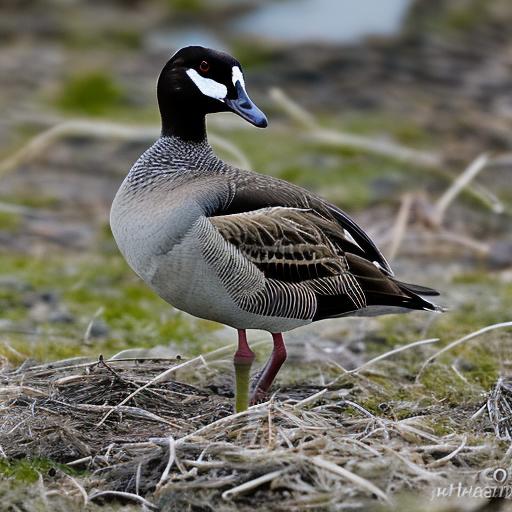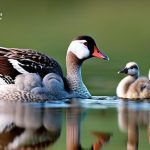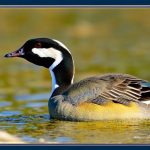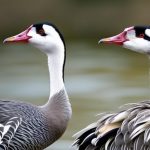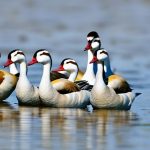Canadian geese, also known as Canada geese, are a familiar sight in North America, known for their distinctive honking and V-shaped flight formations. These large waterfowl are known for their strong family bonds and their impressive breeding habits. Canadian geese are monogamous birds, forming lifelong pair bonds with their mates. They typically breed in the northern regions of North America, including Canada and the northern United States. Breeding season for Canadian geese usually begins in early spring, when the birds return to their breeding grounds after wintering in the southern regions. During this time, they engage in a series of behaviors and rituals that are essential to the successful hatching and raising of their young.
The Nesting Process: Choosing the Right Location
The nesting process is a crucial part of the breeding habits of Canadian geese. These birds are known for their strong nest site fidelity, often returning to the same nesting sites year after year. When it comes to choosing the right location for their nest, Canadian geese are quite selective. They prefer nesting near water, such as lakes, ponds, or marshes, where they can easily access food and escape from predators. The female goose, known as the “goose,” is primarily responsible for selecting the nest site. She looks for a location that is elevated and offers good visibility, allowing her to keep an eye out for potential threats. Once a suitable location is found, the female begins the process of building the nest, using a combination of twigs, grass, and down feathers to create a comfortable and secure environment for her eggs.
The Role of Both Parents in Incubating the Eggs
Once the nest is built and the female has laid her eggs, both parents play a crucial role in the incubation process. Canadian geese typically lay a clutch of 4-7 eggs, with one egg laid each day until the clutch is complete. After the last egg is laid, the incubation period begins, with both parents taking turns to keep the eggs warm. The male goose, known as the “gander,” takes the first shift, allowing the female to leave the nest to feed and rest. The female then takes over, allowing the male to do the same. This alternating pattern continues for about 25-28 days, until the eggs are ready to hatch. This shared responsibility allows both parents to maintain their strength and energy levels, ensuring that they are able to care for their young once they hatch.
The Incubation Period: How Long Does it Last?
The incubation period for Canadian geese typically lasts for about 25-28 days. During this time, the eggs are kept warm and protected in the nest, as the parents take turns to incubate them. The process of incubation is essential for the development of the embryos inside the eggs, as the warmth provided by the parents’ bodies is necessary for their growth and survival. Throughout the incubation period, the parents are highly vigilant, constantly on the lookout for potential threats and predators that may pose a danger to their eggs. They are also careful to regulate the temperature of the eggs, using their bodies to provide warmth or shade as needed. As the days pass, the parents become increasingly protective of their nest, ensuring that their eggs have the best possible chance of hatching successfully.
Protecting the Nest: How Canadian Geese Defend Their Eggs
Protecting the nest is a top priority for Canadian geese during the breeding season. These birds are known for their aggressive behavior when it comes to defending their eggs and young. When a potential threat approaches the nest, such as a predator or a human intruder, the geese will not hesitate to take action. They may hiss, flap their wings, or even charge at the intruder in an attempt to drive them away. This behavior is not just for show – Canadian geese are strong and capable of inflicting injury with their powerful beaks and wings. They are also known to emit loud honking calls as a warning to potential threats. This aggressive behavior serves as a deterrent, helping to keep the nest and eggs safe from harm.
Hatching: The Arrival of Goslings
After the 25-28 day incubation period, the eggs are ready to hatch, and the arrival of the goslings is an exciting and joyous occasion for the parents. The hatching process can take several hours, as the goslings use their egg tooth to break through the shell. Once they have hatched, the parents are quick to help them out of the nest and into the water, where they are safer from predators. The goslings are born with their eyes open and are covered in down feathers, allowing them to swim and forage for food almost immediately. The parents are highly protective of their young at this stage, keeping a close watch as the goslings explore their new surroundings. The family will remain close together, with the parents guiding and teaching the goslings essential survival skills.
Parental Care: How Canadian Geese Raise Their Young
Parental care is a crucial aspect of the breeding habits of Canadian geese. Both the male and female play an active role in raising their young, providing them with food, protection, and guidance. The parents lead their goslings to feeding areas, where they can find a variety of plants, insects, and small aquatic creatures to eat. They also teach them how to forage for food on their own, a skill that will be essential for their survival. The parents are highly attentive to the needs of their young, keeping a close eye on them and responding quickly to any signs of distress. They also provide warmth and shelter, allowing the goslings to snuggle under their wings for protection. This close bond between the parents and their young is essential for the goslings’ development and well-being.
Challenges and Threats During the Breeding Season
The breeding season is a challenging time for Canadian geese, as they face a variety of threats and obstacles that can impact the survival of their young. Predators such as foxes, raccoons, and birds of prey pose a significant danger to the eggs and goslings, and the parents must remain vigilant to protect them. Human disturbances, such as habitat destruction and pollution, also pose a threat to the breeding success of Canadian geese. Nesting sites near urban areas are particularly vulnerable to these disturbances, as human activity can disrupt the nesting process and cause stress to the birds. Climate change is another concern, as it can impact the availability of food and suitable nesting sites for the geese. Despite these challenges, Canadian geese have shown remarkable resilience and adaptability, finding ways to overcome these obstacles and ensure the survival of their young.
Migration and Breeding: How Canadian Geese Balance Both
Migration is a fundamental part of the life cycle of Canadian geese, and it plays a crucial role in their breeding habits. After the breeding season is over, the geese begin their long journey south, where they will spend the winter in warmer climates. Migration is a challenging and demanding process, requiring the geese to travel thousands of miles to reach their wintering grounds. Despite the physical demands of migration, Canadian geese are able to balance this with their breeding habits, returning to their nesting sites year after year. They have a strong homing instinct, allowing them to find their way back to the same locations with remarkable accuracy. This ability to balance migration and breeding is essential for the survival of the species, ensuring that they are able to continue their life cycle and maintain healthy populations.
Conservation Efforts: Protecting Canadian Geese and Their Breeding Grounds
Conservation efforts play a vital role in protecting Canadian geese and their breeding grounds. These birds face a variety of threats, including habitat loss, pollution, and hunting, which can impact their breeding success and overall population numbers. Conservation organizations and government agencies work to protect and preserve the natural habitats of Canadian geese, ensuring that they have suitable nesting sites and access to food and water. Efforts are also made to reduce human disturbances near nesting areas, such as the implementation of buffer zones and restrictions on human activity. Conservationists also work to raise awareness about the importance of Canadian geese and the need to protect their breeding grounds. Through these efforts, it is hoped that Canadian geese will continue to thrive and contribute to the rich biodiversity of North America for generations to come.
Meet Walter, the feathered-friend fanatic of Florida! Nestled in the sunshine state, Walter struts through life with his feathered companions, clucking his way to happiness. With a coop that’s fancier than a five-star hotel, he’s the Don Juan of the chicken world. When he’s not teaching his hens to do the cha-cha, you’ll find him in a heated debate with his prized rooster, Sir Clucks-a-Lot. Walter’s poultry passion is no yolk; he’s the sunny-side-up guy you never knew you needed in your flock of friends!

